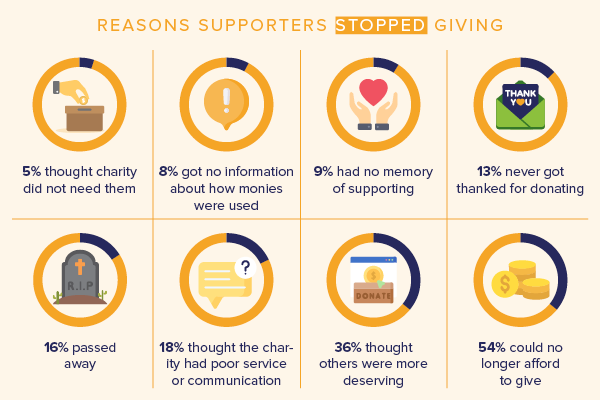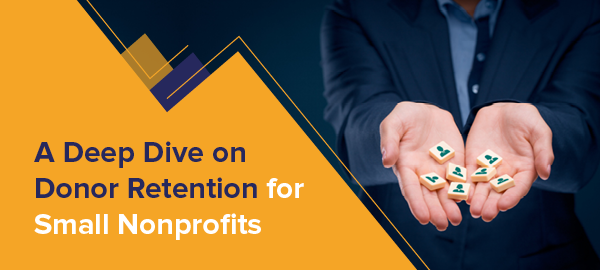Professionals working at small nonprofits are often immensely focused on new and exciting opportunities for growth. This is because these organizations are generally still working very hard to get off the ground running.
They’re looking for the next opportunity to spread the name of their organization far and wide, attracting as many new supporters as possible to get excited about the mission. These new supporters are invited to get involved in fundraising campaigns, the next event, and ever-present volunteer opportunities.
While the acquisition of new supporters is absolutely necessary to obtain growth, small organizations too often forget about the other important metric necessary for efficient growth: donor retention.
It’s often up to ten times more expensive to acquire new supporters than it is to retain your existing ones. Therefore, instead of constantly replenishing your supporters who lapse after the first donation, retaining the supporters you’ve already worked so hard to acquire offers a faster road to growth.
Here at Bloomerang, we understand the value of donor retention. In fact, we built our entire software system with retention in mind to empower nonprofits like yours with the necessary tools to increase retention rates and grow fundraising. We’ve pulled some insights from Bloomerang’s comprehensive retention guide to share with you here, focusing specifically on how small nonprofits can leverage retention to improve fundraising and grow impact. We’ll cover:
- Calculating Donor Retention
- Common Reasons Donors Lapse
- The Golden Donation
- Additional Donor Retention Strategies
Ready to take a deep dive into the power of donor retention? Let’s get started.
Calculating Donor Retention
Donor retention is immensely valuable for nonprofits of all shapes and sizes. Not only does it allow you to spend less on acquisition costs, but supporters also often give more to organizations the longer they’re involved with the mission.
But how can you unlock this powerful tool for growth? The first step is to start tracking your own donor retention rate. This will give you a starting point from which your organization can start building your strategy. It’s how you’ll calculate and track progress.
The image below shows the basic calculation that you’ll need to know to determine your initial retention rate:
Returning donors in year #2 divided by all donors in year #1 equals your retention rate.
The best nonprofit CRM software will actually calculate this retention rate for you, providing information about the trends in your donor retention, allowing you to track your progress. This database is the perfect place to track your retention rate because it houses all of your donor data and engagement histories.
If your database enables you to track this metric, add it to your dashboard so that it’s front and center, encouraging your team to keep retention front of mind at all times.
Common Reasons Donors Lapse
Once you’ve calculated your donor retention rate, you can start considering how you’ll make improvements. The first step is to consider why donors don’t stay with your organization. Why are they lapsing?
Every nonprofit has a certain amount of natural lapse that occurs for reasons outside of their control, but many reasons for lapsing are entirely within your organization’s control. This guide provides the helpful image below with the various reasons supporters stop giving to nonprofits, based on Adrian Sargeant’s study on the matter:

- 5% thought the charity did not need them
- 8% got no information about how the monies were used
- 9% had no memory of supporting the organization
- 13% never got thanked for donating
- 16% passed away
- 18% thought the charity had poor service or communication
- 36% thought other charities were more deserving
- 54% could no longer afford to give
Of course, when supporters pass away or fall on hard times and can’t afford to give, that’s outside the control of your organization. However, the other reasons for donor lapse are within the control of your nonprofit. By building out your organization’s marketing strategy, you’ll be able to address some of the most common reasons people stop donating.
For instance, let’s consider the first four ideas listed above: donors who think the charity doesn’t need them, didn’t get information about how the funds were used, had no memory of supporting, and never got thanked for donating. All of these reasons for lapsing can be addressed with a simple letter of appreciation, usually with a message that reads something like this:
Dear Mark,
Thank you for your contribution to the Feed a Dolphin campaign. Your donation of $100 allowed us to feed Tommy the dolphin for a week. Tommy appreciates your contribution too. We’ve enclosed a picture of him for you!
By communicating the impact that supporters’ donations had on the organization, your supporters recognize that their gifts were necessary and know what the funds were used for. Plus, by opening up the line of communication and thanking them, it’s unlikely that the supporter will forget their contribution or feel unappreciated.
The Golden Donation
The “golden donation” is the second gift that supporters give to an organization. This is called the golden donation because supporters are much more likely to continue giving after they’ve given this second gift.
The Fundraising Effectiveness Project cites a couple of statistics to illustrate this point. The average new donor retention rate (those who give again after their first contribution) is only around 20%. Meanwhile, after a second donation is given, the repeat donor retention rate jumps to over 60%.
When you capture the second donation from a supporter, you dramatically increase the chances that they’ll continue giving again in the future. This means you’ll need more than an impressive fundraising form to retain your supporters—you’ll need a specific strategy.
We recommend creating a specific strategy and timeline that you can use to recapture the attention of your first-time supporters and encourage them to maintain involvement. The ideal strategy to do this isn’t riddled with asks. Instead, it emphasizes appreciation and information. Your new donor engagement strategy might include items such as:
- Sending an immediate appreciation email. Draft a confirmation email to send immediately after a supporter gives to your organization. If you include all of the elements in a proper appreciation letter, you can use this as an opportunity to both confirm the contribution was received and say thank you to supporters. Fundraising Letters offers templates that you can use to include all necessary appreciation elements in this automated email.
- Calling donors to say thank you. Don’t only use an email to lead your appreciation strategy. Go the extra mile to call your supporters and say thank you for their support. This is an opportunity to create a personal connection with them and invite them to get involved with other aspects of your organization, such as reading mission literature.
- Inviting them to read your newsletter. Send new supporters your latest newsletter so they can get caught up on the latest activities and programs of your organization. This also provides insight into your program initiatives and priorities, offering even more opportunities for new supporters to get involved.
- Sending another thank you note from leadership. Send a follow-up thank you note after your supporter gives. This should be a more in-depth and personalized thank you for the contribution that the supporter gave. It’s even better if this letter is hand-written or signed by a leader at the organization.
- Collecting feedback through a survey. Show your new supporters that you care about and value their insights and opinions. Send a survey so that they can share their experience, explain why they contributed to your organization, and otherwise provide feedback.
As you can see, none of the above suggestions require you to ask for another donation from your supporter. The second ask shouldn’t come until after you’ve completed at least some of these stewardship activities.
Additional Donor Retention Strategies
In general, at the heart of donor retention is relationships. When you develop relationships with your supporters, they’ll come back and continue giving to your organization for the long haul. Therefore, when you’re determining how you’ll retain your supporters, consider what you’ll need to do to initiate a relationship.
Relationships are always a two-way street, so you need to play your part. The following retention strategies are commonly used to help nonprofits develop these relationships:
- Communicate impact. Supporters want to know and understand where their funds are going. Communicating the impact that they’ve had on your mission is a great way for you to show your supporters just how much you’ve accomplished with their help.
- Show appreciation. Appreciation is more than just a polite gesture. Have you ever given a gift to a friend and they didn’t say thank you? You probably felt a bit bitter afterwards. The same is true for supporters. It starts relationships off on a good foot if you send a genuine thank you.
- Personalize communications. Segment your supporters in your donor database and include personal details in your communications with them. This shows supporters that they’re not just a part of the crowd—they’re special and important teammates for your organization.
- Invite supporters to events. Events (whether in-person, virtual, or hybrid) include activities and opportunities for one-on-one communication and mingling. Invite supporters personally and encourage them to attend to make these important relationship-building activities possible.
- Encourage volunteering. Volunteering is a great way to give supporters’ wallets a break while still encouraging them to get involved with your mission. Plus, you might still be able to make some money! Encourage your volunteers to look up their eligibility for grants associated with volunteer hours. Some companies offer grant funds in exchange for their employees giving a certain number of hours volunteering to eligible nonprofits.
Consider your own audience and the types of stewardship strategies that they might prefer when it comes to developing relationships. Relationship-building is an important and effective strategy for every type of supporter, helping organizations retain their new supporters or cultivate major gifts. Prioritizing relationships will help you raise more at every level.
While many small nonprofits focus on the acquisition of new supporters as their pathway to growth and success, it’s important to strike a balance between that and donor retention. You should acquire new supporters, but you should do so with a retention strategy in place so that your organization achieves sustainable growth rather than temporary new support.
Author: Jay Love
Co-Founder and current Chief Relationship Officer at Bloomerang
He has served this sector for 33 years and is considered the most well-known senior statesman whose advice is sought constantly.
Prior to Bloomerang, he was the CEO and Co-Founder of eTapestry for 11 years, which at the time was the leading SaaS technology company serving the charity sector. Jay and his team grew the company to more than 10,000 nonprofit clients, charting a decade of record growth.
He is a graduate of Butler University with a B.S. in Business Administration. Over the years, he has given more than 2,500 speeches around the world for the charity sector and is often the voice of new technology for fundraisers.



1 thought on “A Deep Dive on Donor Retention for Small Nonprofits”